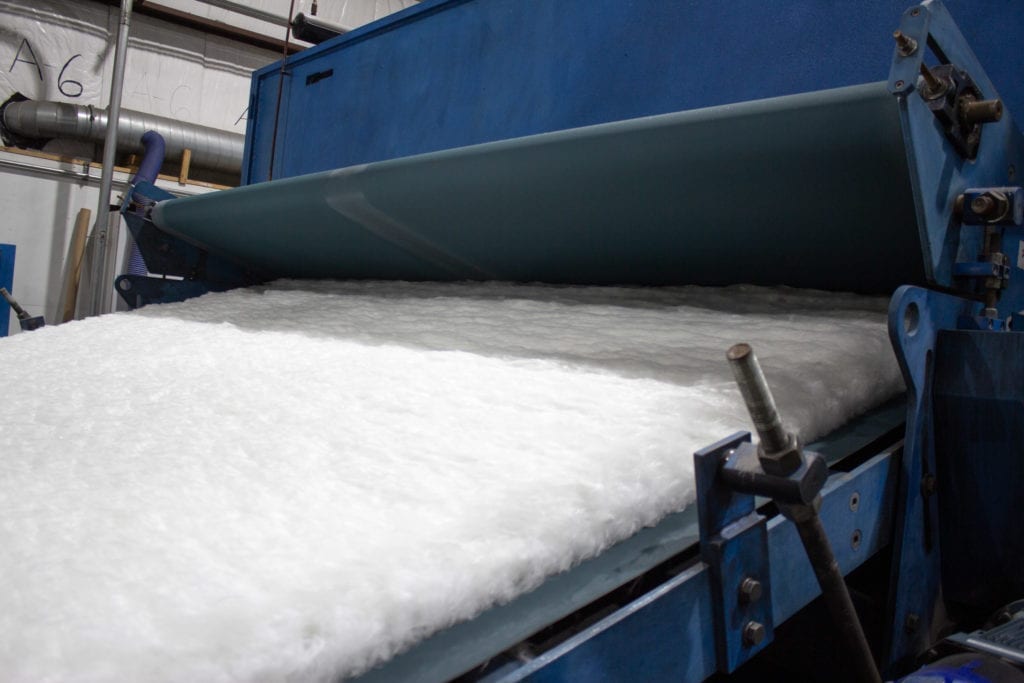What Is Airlay Felt Manufacturing?
The term airlay refers to the web formation process. It replaces the use of traditional carding and cross-lapper mechanical systems by using air as its operating principle. At BIT, we have been manufacturing 100% fiberglass non-woven materials for high-temperature insulation using our airlay machine since 2017.
Airlay manufacturing techniques first originated in the 1960s to produce paper without water as a carrying medium. With new technological advances to production technology, the manufacturing process has lent itself to creating non-woven materials for industrial application.
Where Is Airlay Felt Used?
Airlaid nonwoven products are typical everyday products you can find in your homes, like wet wipes, household cleaning wipes, and napkins. Hygiene dominates the largest market for airlay, with food pads and medical products following close behind.
By volume, feminine hygiene products take the lead. Another very common application and BIT’s major market for airlay production is in the thermal and acoustical insulation market. In that application, an airlay’s unique ability to build lofty (thick), low density products shines in creating excellent insulators.
Because non-woven fabrics are available with a variety of characteristics, airlay nonwovens provide textiles for a multitude of industries:
- Apparel
- Automotive
- Filtration
- Bedding
- Geotextiles
- Packaging
- PPE
- Thermal Insulation
- Acoustical Insulation
Why Use Airlay Felt Manufacturing?
The general properties of airlay fabrics are:
- High loft structure (thicker)
- High porosity
- Good absorbency and wicking rate
- Resilient with thermal retardant characteristics
- Adequate tensile strength
Its advanced adjustment processes equal greater accuracy in controlling weight range and density uniformity cross and lengthwise on the machine. It can run up to 2,000lbs of material an hour versus a traditional carding machine at 600lbs an hour.
And because it can run almost anything through its system (from foam to even sawdust), it has slowly become a great choice for creating more sustainable materials from organic bases.

How Is Airlay Felt Made?


1. Raw Fiber Selection
The airlay process begins with raw fibers. These are chosen depending on the material composition of the finished product. Once the fibers have been prepared and weighed, they are fed through large piping systems to openers.
2. Open The Fiber
The openers disentangle and loosen the fibers using a pressurized air system using feed rolls and a full pinned cylinder. This part of the process is essential for ensuring the finished product is smooth and without imperfections such as clumps and indents.
3. Orient In Single Direction
Once the fibers have been loosened and mixed accordingly, they are oriented in a singular direction to form a web with the desired weight and thickness of the final product. Fibers oriented in the same direction gives them loft.
4. Finishing
The web then undergoes traditional mechanical bonding using our needle punch loom. Other common finishing processes for airlaid felt materials (which BIT does not use) is heat and chemical bonding. Mechanical bonding has many benefits over heat or chemical bonding because it can make an even denser final product.
What Makes BIT Airlay Different?
Most airlay manufacturers are able to make either very thick and lofty felt or thin and airy felt. Our airlay machines are designed to make extremely dense felt unlike anything our competitors can produce. This is due to custom-designed airlay machines and a needling finish, as compared to heating in an oven, which makes our felt even denser.
Another plus is that it our machines are designed to run fiberglass which most other airlay machines cannot.

